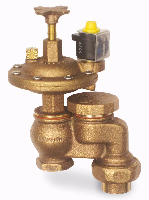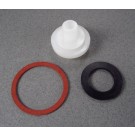When this particular valve (Champion Classic 3/4" As Max PSI 150 466 Max Temp 110o) turns on, a lot of water starts coming out of the the bottom part of the valve which I've highlighted in the image. I can see the sprinkler heads get a little wet, but they don't "pop". Can somebody tell me what that spot on the valve is for and what I could do fix the problem?

The longer version in case it's helpful: A short while ago, my wife flipped out because the sprinkler made a sound of being on, but water wasn't coming out of the sprinkler heads. I turned off the controller (which is located in an inconvenient spot) that night, so I could revisit it the following weekend. When I looked at it, I saw the main sprinkler valve was mostly shut (my three year old at work, no doubt). So I turned it back on, and the following sprinkler schedule had the same problem. I turned the controller off again. The following weekend, I experimented with the system and the first zone was the only one with the problem outlined above. I can't find anything similar on the internet, and hoping somebody has some guidance.






